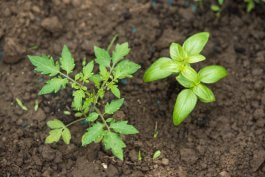
There are a lot of ways to grow a successful garden. Companion planting is one of the best “next level” strategies to help with that goal.
If you want healthy, thriving plants, fewer pests, and more pollinators in your garden, companion planting is an easy, organic way to accomplish your goals. Companion plants have mutually beneficial relationships, and there are any number of ways these plants might help each other.
One of the most famous examples of garden companion planting is the grouping of corn, beans, and squash. Beans use the tall corn stalks for support as they climb. Squash grows quickly and its large leaves help prevent weeds while keeping the soil moist. And beans add nitrogen to the soil, which both corn and squash need to stay healthy.
Another famous pairing is tomatoes and basil. The aroma of basil deters some of the pests that would normally feed on tomatoes. And basil flowers also attract pollinators. In turn, the tall tomato plant can shade the basil from hot, midday sun.
As a matter of fact, most herbs are ideal for garden companion planting, as the strong scents confuse and deter pests. Mint deters ants, while catnip and sage will keep the cabbage moth away. Other herbs, like dill and parsley can attract beneficial insects, such as ladybugs.
You don’t have to stick to herbs and vegetables, either. Marigolds, for example, keep the root-destroying nematodes away, while nasturtiums are a favorite of aphids, drawing them away from other plants.

It’s important to point out that not every plant in your garden makes for a good neighbor. Some plants compete too much for the same nutrients or may cast too much shade on nearby plants.
For example, garlic may limit the growth of beans and peas. Other plants, such as tomatoes and corn, get attacked by the same worm, while tomatoes and potatoes can suffer from the same blight.
For the most part, though, companion planting is an efficient and effective way to grow a healthier, more abundant garden. Before you plant the seeds you’re most looking forward to for your Freedom Garden, first do some research as to which companion plants will work best.
And if you’re working on a community plot, it’s worth talking to your fellow gardeners about what they intend to plant and where. In future years, you’ll also want to coordinate crop rotation, which we’ll talk about next.


 Previous
Previous

